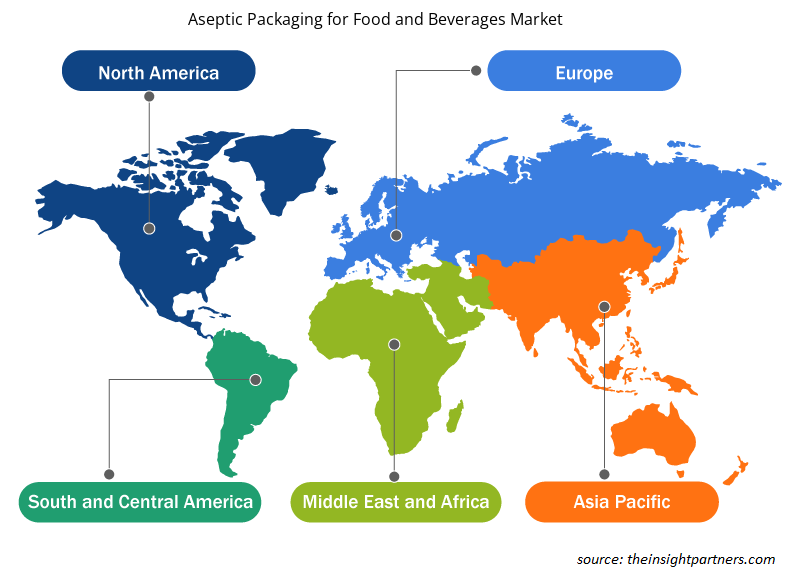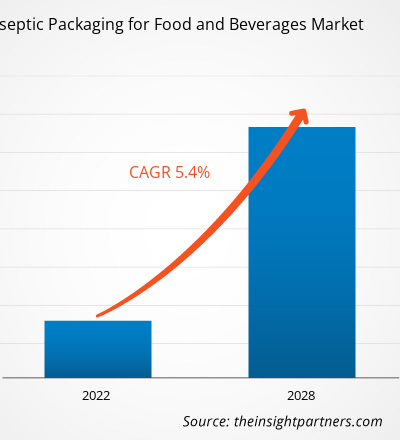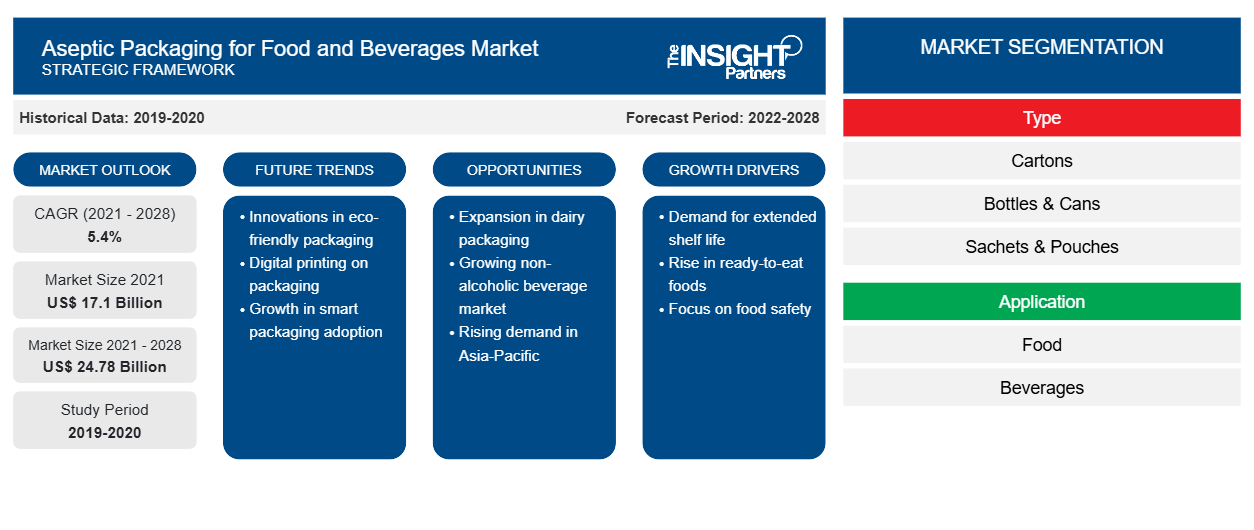Si prevede che il mercato degli imballaggi asettici per alimenti e bevande raggiungerà i 24.782,33 milioni di dollari nel 2028, rispetto ai 17.097,86 milioni di dollari nel 2021; si prevede una crescita a un CAGR del 5,4% dal 2021 al 2028.
Il confezionamento asettico è un processo termico ad alta temperatura e breve durata utilizzato per sterilizzare commercialmente un prodotto e riempire il prodotto raffreddato e sterilizzato in una confezione pre-sterilizzata in un ambiente sterilizzato. Durante il processo, la riempitrice asettica è progettata per sterilizzare il materiale di confezionamento, riempire il prodotto sterile nel contenitore in un ambiente sterilizzato e quindi sigillare ermeticamente la confezione. La riempitrice asettica differisce dai tradizionali sistemi di confezionamento alimentare, in quanto in questo caso il prodotto alimentare e la confezione vengono sterilizzati separatamente. Il confezionamento asettico è utilizzato principalmente nell'industria alimentare e delle bevande. La massiccia crescita dell'industria alimentare e delle bevande a livello globale è dovuta all'aumento della popolazione, al miglioramento degli stili di vita, all'aumento del reddito pro capite e alla crescente domanda di cibi e bevande pronti, che si prevede apriranno opportunità cruciali per il confezionamento asettico per il mercato alimentare e delle bevande nel periodo di previsione.
Il Nord America ha detenuto la quota maggiore del mercato globale degli imballaggi asettici per alimenti e bevande nel 2020, mentre si prevede che l'Asia-Pacifico crescerà in modo significativo nel periodo di previsione. Il concetto di pronto da mangiare o da bere è di tendenza in Nord America. Ultimamente, il mercato delle bevande pronte da bere è cresciuto notevolmente a causa della crescente preferenza per cibi e bevande pronti che aiutano a risparmiare tempo e fatica. L'imballaggio asettico per alimenti e bevande è essenziale per estenderne la durata di conservazione. Pertanto, la crescente tendenza al consumo di bevande pronte da bere sta guidando la crescita del mercato degli imballaggi asettici per alimenti e bevande in Nord America. I venditori offrono imballaggi asettici specializzati per prodotti pronti da bere. Ad esempio, Graham Packaging offre plastica riciclabile per imballaggi asettici per garantire una maggiore durata di conservazione per imballaggi monodose. Pertanto, vari attori di mercato emergenti e affermati nella regione che offrono soluzioni innovative di imballaggio asettico stanno guidando la crescita del mercato.
Personalizza questo report in base alle tue esigenze
Riceverai la personalizzazione gratuita di qualsiasi report, comprese parti di questo report, o analisi a livello nazionale, pacchetto dati Excel, oltre a usufruire di grandi offerte e sconti per start-up e università
-
Scopri le principali tendenze di mercato in questo rapporto.Questo campione GRATUITO includerà analisi di dati che spaziano dalle tendenze di mercato alle stime e alle previsioni.
Impatto della pandemia di COVID-19 sul mercato degli imballaggi asettici per alimenti e bevande
Durante la pandemia di COVID-19, il settore chimico e dei materiali ha dovuto affrontare sfide senza precedenti a causa della carenza di materie prime, della chiusura delle fabbriche, della carenza di manodopera e di altre difficoltà operative dovute ai protocolli di sicurezza pandemici. La chiusura delle unità produttive, la difficoltà nell'approvvigionamento di materie prime e le restrizioni alla logistica hanno avuto un impatto negativo sul confezionamento asettico globale per il mercato alimentare e delle bevande. A causa dello scoppio del COVID-19, le preoccupazioni igieniche dei consumatori sono aumentate in modo significativo. Le preferenze dei consumatori si stanno rapidamente evolvendo verso una lunga conservazione e un confezionamento sterile, il che ha avuto un impatto positivo sul confezionamento asettico per il mercato alimentare e delle bevande. Secondo uno studio sull'e-commerce nel Tetra Pak Index 2021, i consumatori hanno sempre più valutato i cartoni asettici come il materiale di imballaggio ideale per gli acquisti online. Pertanto, la crescente preoccupazione per la sicurezza e l'igiene alimentare dovuta allo scoppio del COVID-19 sta alimentando la crescita del confezionamento asettico per il mercato alimentare e delle bevande. Pertanto, la pandemia di COVID-19 ha avuto un impatto misto sul mercato del confezionamento asettico per il mercato alimentare e delle bevande.
Market Insights
I vantaggi associati al confezionamento asettico stanno guidando la crescita del mercato
Ci sono vari vantaggi associati al confezionamento asettico per prodotti alimentari e bevande. Il confezionamento asettico aiuta ad aumentare la durata di conservazione dei prodotti alimentari e bevande di circa sei-dodici mesi senza refrigerazione. La maggiore longevità del prodotto offre ai produttori più tempo per spedire e vendere i loro prodotti prima che scadano o perdano sapore. Ciò ha anche ridotto i costi di trasporto e logistica. Il confezionamento asettico è leggero e compatto rispetto ai tipi di imballaggio più tradizionali, consentendo ai produttori di tagliare i costi di spedizione riducendo il peso della spedizione. C'è stata una crescente domanda di prodotti alimentari pronti con lunga durata di conservazione, che sono privi di contaminazione batterica o possono ritardarla. I conservanti alimentari sono ampiamente utilizzati nella produzione alimentare per aumentare la durata di conservazione e preservare la qualità del prodotto. Tuttavia, i consumatori preferiscono prodotti più naturali privi di additivi sintetici. Il confezionamento asettico integra anche gli ingredienti naturali, consentendo a un produttore di produrre un prodotto completamente naturale e renderlo sempre più stabile a scaffale. Pertanto, vari vantaggi del confezionamento asettico stanno guidando la crescita del mercato del confezionamento asettico per alimenti e bevande.
Tipo Informazioni
In base al tipo, il mercato degli imballaggi asettici per alimenti e bevande è segmentato in cartoni, bottiglie e lattine, bustine e sacchetti e altri. Si prevede che il segmento delle bustine e dei sacchetti crescerà al CAGR più rapido nel mercato globale degli imballaggi asettici per alimenti e bevande nel periodo di previsione. L'imballaggio a sacchetto asettico include una soluzione innovativa di beccuccio e tappo per consentire una soluzione di imballaggio sicura e comoda. Questa bustina è sviluppata per offrire ai consumatori praticità e facilità d'uso. Può avere una durata di conservazione fino a 12 mesi, offrendo al contempo una ritenzione ottimale dei nutrienti, sapori e consistenze. Le bustine sono piccole buste flessibili sigillate che includono imballaggi a tre o quattro strati realizzati con una pellicola arrotolata o piatta. La crescente domanda di prodotti alimentari e bevande in quantità più ridotte sta guidando la crescita del segmento delle bustine e dei sacchetti asettici.
Imballaggi asettici per il mercato alimentare e delle bevande - Approfondimenti regionali
Le tendenze regionali e i fattori che influenzano il mercato degli imballaggi asettici per alimenti e bevande durante il periodo di previsione sono stati ampiamente spiegati dagli analisti di Insight Partners. Questa sezione discute anche i segmenti e la geografia del mercato degli imballaggi asettici per alimenti e bevande in Nord America, Europa, Asia Pacifico, Medio Oriente e Africa e America meridionale e centrale.

- Ottieni i dati specifici regionali per il mercato degli imballaggi asettici per alimenti e bevande
Ambito del rapporto di mercato sugli imballaggi asettici per alimenti e bevande
| Attributo del report | Dettagli |
|---|---|
| Dimensioni del mercato nel 2021 | 17,1 miliardi di dollari USA |
| Dimensioni del mercato entro il 2028 | 24,78 miliardi di dollari USA |
| CAGR globale (2021 - 2028) | 5,4% |
| Dati storici | 2019-2020 |
| Periodo di previsione | 2022-2028 |
| Segmenti coperti |
Per tipo
|
| Regioni e Paesi coperti |
America del Nord
|
| Leader di mercato e profili aziendali chiave |
|
Confezionamento asettico per alimenti e bevande Attori del mercato Densità: comprendere il suo impatto sulle dinamiche aziendali
Il mercato del confezionamento asettico per alimenti e bevande sta crescendo rapidamente, spinto dalla crescente domanda degli utenti finali dovuta a fattori quali l'evoluzione delle preferenze dei consumatori, i progressi tecnologici e una maggiore consapevolezza dei benefici del prodotto. Con l'aumento della domanda, le aziende stanno ampliando le loro offerte, innovando per soddisfare le esigenze dei consumatori e capitalizzando sulle tendenze emergenti, il che alimenta ulteriormente la crescita del mercato.
La densità degli operatori di mercato si riferisce alla distribuzione di aziende o società che operano in un particolare mercato o settore. Indica quanti concorrenti (operatori di mercato) sono presenti in un dato spazio di mercato in relazione alle sue dimensioni o al valore di mercato totale.
Le principali aziende che operano nel mercato degli imballaggi asettici per alimenti e bevande sono:
- Tetra Pak ItaliaPak International S.A
- Aria sigillata
- Azienda di imballaggio asettico Greatview Aseptic Packaging Company
- GRUPPO SIDEL GROUP
- ECOLEAN AB AB
Disclaimer : le aziende elencate sopra non sono classificate secondo un ordine particolare.

- Ottieni la panoramica dei principali attori del mercato degli imballaggi asettici per alimenti e bevande
Approfondimenti sulle applicazioni
In base all'applicazione, il mercato degli imballaggi asettici per alimenti e bevande è segmentato in alimenti e bevande. Il segmento alimentare è ulteriormente suddiviso in latticini; frutta e verdura; carne, pollame e frutti di mare; alimenti trasformati; e altri. Il segmento delle bevande è ulteriormente suddiviso in latticini, succhi, bevande pronte da bere e altri. Il segmento delle bevande ha detenuto una quota maggiore nel mercato globale nel 2020. Gli imballaggi asettici sono utilizzati per varie bevande, tra cui a base di frutta, latticini, latte, frullati proteici, tè pronto da bere (RTD) e caffè freddo, acque aromatizzate e cocktail. La crescente domanda da parte dei consumatori di bevande senza sostanze chimiche e conservanti sta guidando la crescita degli imballaggi asettici per il mercato degli alimenti e delle bevande.
I principali attori che operano nel mercato del confezionamento asettico per alimenti e bevande includono Tetra Pak International SA, Sealed Air, Greatview Aseptic Packaging Company, Sidel Group, ECOLEAN AB, Krones AG, Syntegon Technology GmbH (Bosch Packaging Technology), Amcor Group GmbH, IPI Srl e SIG Combibloc Group AG. Questi attori sono impegnati nello sviluppo di prodotti innovativi per soddisfare le tendenze emergenti dei consumatori. Inoltre, sono coinvolti in fusioni e acquisizioni, espansione aziendale e partnership per espandere la loro quota di mercato a livello globale.Pak International SA, Sealed Air, Greatview Aseptic Packaging Company, Sidel Group, ECOLEAN AB, Krones AG, Syntegon Technology GmbH (Bosch Packaging Technology), Amcor Group GmbH, IPI S.r.l., and SIG Combibloc Group AG. These players are engaged in developing innovative products to meet the emerging consumer trends. Moreover, they are involved in mergers & acquisitions, business expansion, and partnerships to expand their market share globally.
Segnala i riflettori
- Tendenze industriali progressive nel mercato degli imballaggi asettici per alimenti e bevande per aiutare gli operatori a sviluppare strategie efficaci a lungo termine
- Strategie di crescita aziendale adottate dai mercati sviluppati e in via di sviluppo
- Analisi quantitativa del mercato degli imballaggi asettici per alimenti e bevande dal 2019 al 2028
- Stima della domanda globale di imballaggi asettici per alimenti e bevande
- Analisi delle cinque forze di Porter per illustrare l'efficacia degli acquirenti e dei fornitori che operano nel settore
- Sviluppi recenti per comprendere lo scenario competitivo del mercato
- Tendenze e prospettive di mercato, nonché fattori che guidano e frenano la crescita del mercato degli imballaggi asettici per alimenti e bevande
- Assistenza nel processo decisionale evidenziando le strategie di mercato che sostengono l'interesse commerciale, portando alla crescita del mercato
- La dimensione del mercato degli imballaggi asettici per alimenti e bevande in vari nodi
- Panoramica dettagliata e segmentazione del mercato, nonché dinamiche del settore dell'imballaggio asettico per alimenti e bevande
- Dimensioni del mercato degli imballaggi asettici per alimenti e bevande in diverse regioni con promettenti opportunità di crescita
- Analisi storica (2 anni), anno base, previsione (7 anni) con CAGR
- Analisi PEST e SWOT
- Valore/volume delle dimensioni del mercato - Globale, Regionale, Nazionale
- Industria e panorama competitivo
- Set di dati Excel
Report recenti
Rapporti correlati
Testimonianze
Motivo dell'acquisto
- Processo decisionale informato
- Comprensione delle dinamiche di mercato
- Analisi competitiva
- Analisi dei clienti
- Previsioni di mercato
- Mitigazione del rischio
- Pianificazione strategica
- Giustificazione degli investimenti
- Identificazione dei mercati emergenti
- Miglioramento delle strategie di marketing
- Aumento dell'efficienza operativa
- Allineamento alle tendenze normative























 Ottieni un campione gratuito per - Imballaggi asettici per il mercato alimentare e delle bevande
Ottieni un campione gratuito per - Imballaggi asettici per il mercato alimentare e delle bevande